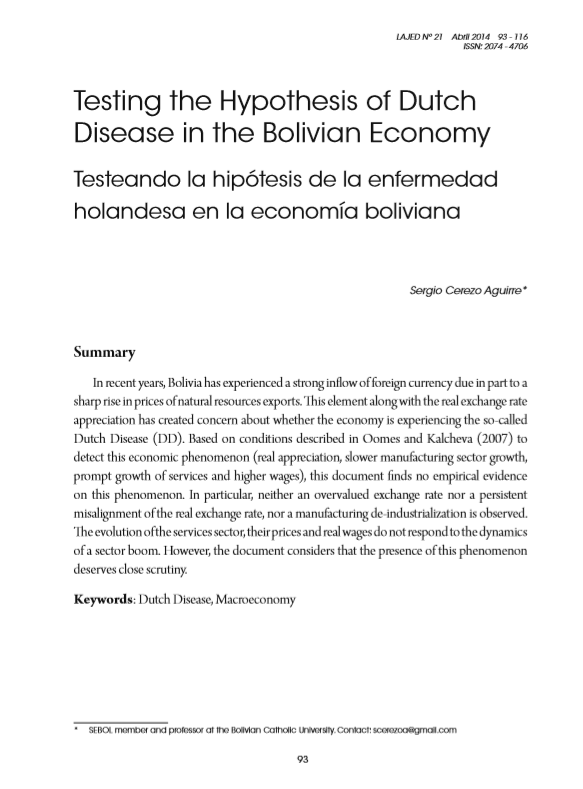Testing the Hypothesis of Dutch Disease in the Bolivian Economy
DOI:
https://doi.org/10.35319/lajed.20142196Keywords:
Dutch Disease, MacroeconomyAbstract
In recent years, Bolivia has experienced a strong inflow of foreign currency due in part to a sharp rise in prices of natural resources exports. This element along with the real exchange rate appreciation has created concern about whether the economy is experiencing the so-called Dutch Disease (DD). Based on conditions described in Oomes and Kalcheva (2007) to detect this economic phenomenon (real appreciation, slower manufacturing sector growth, prompt growth of services and higher wages), this document finds no empirical evidence on this phenomenon. In particular, neither an overvalued exchange rate nor a persistent misalignment of the real exchange rate, nor a manufacturing de-industrialization is observed. The evolution of the services sector, their prices and real wages do not respond to the dynamics of a sector boom. However, the document considers that the presence of this phenomenon deserves close scrutiny.
Downloads
References
Adam, Christopher S. and David L. Bevan, (2003), “Aid, Public Expenditure and Dutch Disease,” Centre for the Study of African Economies Working Paper 2003–02 (Oxford: University of Oxford).
Cerutti, Eugenio and Mario Mansilla (2008), Bolivia: The Hydrocarbons Boom and the Risk of Dutch Disease. IMF, Working paper: WP/08/154. June 2008.
Clark, P., and R. MacDonald, (1998), “Exchange Rate and Economic Fundamentals: A Methodology Comparison of BEERs and FEERs,” IMF Working Paper 98/67 (Washington: International Monetary Fund).
Corden, W. Wax, and J. Peter Neary, (1982), “Booming Sector and De-Industrialisation in a Small Open Economy,” The Economic Journal, Vol. 92 (December), pp. 825–48.
Corden, M., (1984), “Booming Sector and Dutch Disease Economics: Survey and Consolidation,” Oxford Economic Papers, Vol. 36, November, pp. 359–80.
Delgadillo, Maria, and Rolando Pardo, (2005), Ingresos del Sector Hidrocarburos, Una Aproximación a la Incidencia Fiscal del Sistema Tributario en el Sector Hidrocarburos en los Periodos Pre y Post Capitalizacion, UDAPE.
Edwards, Sebastian, (1989), Real Exchange Rates, Devaluation, and Adjustment (Cambridge, Massachusetts: MIT Press).
Gylfason, Thorvaldur, (2004), “Natural resources and Economic growth: from dependence to diversification,” CEPR Discussion paper 4804.
Koranchelian, T., (2005), “The Equilibrium Real Exchange Rate in a Commodity Exporting Country, Algeria’s Experience,” IMF Working Paper No. 05/135 (Washington: International Monetary Fund).
Mevius, François-Xavier de e Albarracin, Ivan (2008), Bolivia and the Dutch Disease: What are the Risks and How to Avoid Them? Documento de Trabajo No. 09/08, IISECUCB.
Oomes , Nienke & Kalcheva, Katerina, 2007. “Diagnosing Dutch disease: Does Russia have the symptoms?,” BOFIT Discussion Papers 7/2007, Bank of Finland, Institute for Economies in Transition.
Paiva, C., (2006), “External Adjustment and Equilibrium Exchange Rate in Brazil,” IMF Working Paper 06/221 (Washington: International Monetary Fund).
Sachs, Jeffrey D. and Andrew M. Warner, (1995) (revised 1997 and 1999), “Natural resource abundance and economic growth,” National Bureau of Economic Research Working Paper No. 5398 (Cambridge, Mass: NBER).
Sala-i-Martin, Xavier, and Arvind Subramanian, 2003, “Addressing the Natural Resource Curse, An Illustration from Nigeria,” IMF Working Paper 03/139 (Washington: International Monetary Fund).
Zalduendo, J., (2006), “Determinants of Venezuela’s Equilibrium Exchange Rate,” IMF Working Paper 06/74 (Washington: International Monetary Fund).






